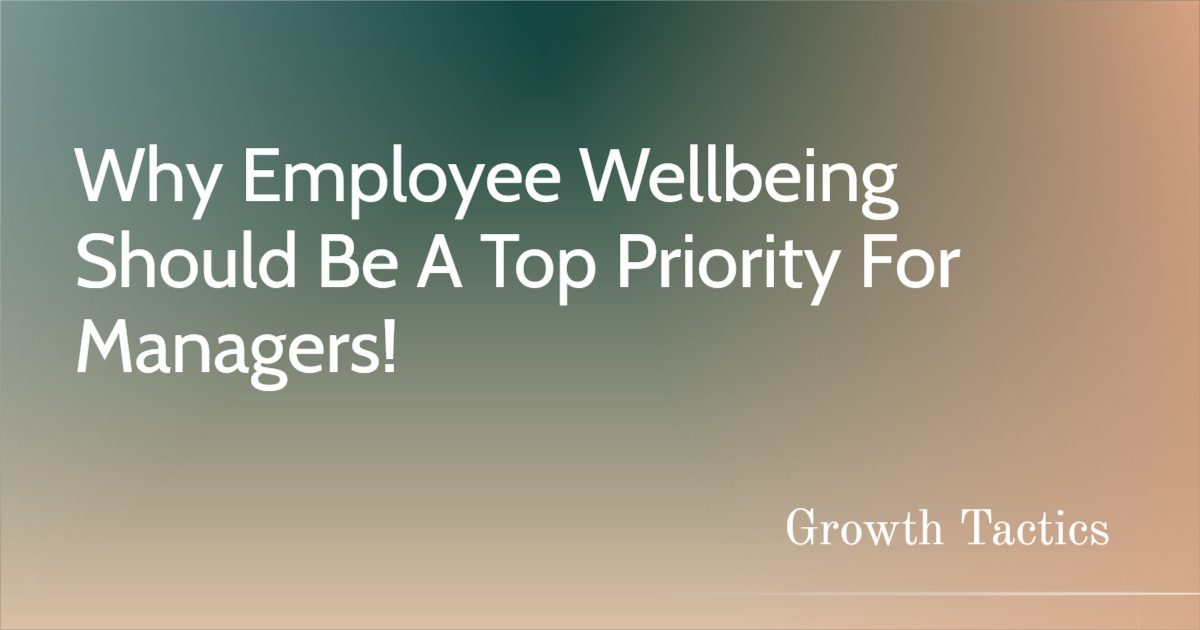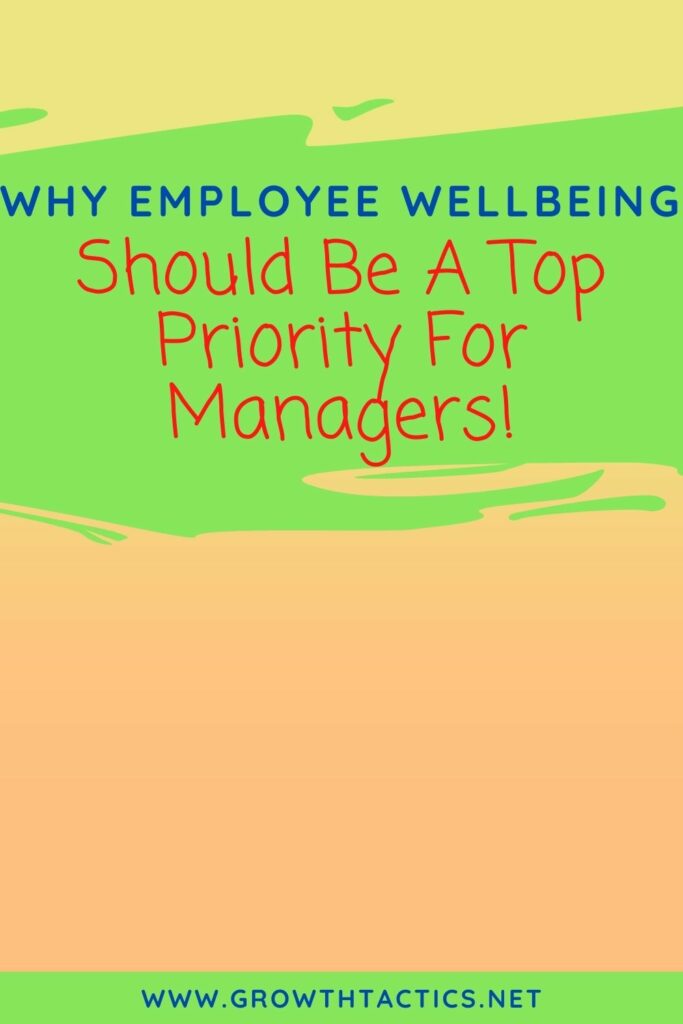In my extensive experience leading teams and managing personnel, I’ve come to understand one fundamental truth: our people are our most valuable assets. This realization has made it clear that for any organization to enjoy sustained growth and enhanced productivity, prioritizing the well-being of employees is not just important, it’s essential!
Whether you’re in a management position or part of the human resources department, you’re likely aware of the significant impact employee well-being has on the success of your business. Investing in your employees’ well-being is proven to boost productivity, decrease turnover, and ultimately, drive higher profits.
But recognizing the importance of employee well-being is just the first step. The real challenge lies in understanding how to effectively promote and improve it within your organization. This article aims to bridge that gap by offering practical, actionable advice that you can start implementing immediately to make a positive change in your workplace.
Jump To Section
What is Employee well-being?
Employee well-being is a term used to describe the state of mind and physical health of employees. Traditional HR focuses on eliminating legal liability and improving productivity. Employee well-being goes beyond those concerns to help you retain employees who are happy, healthy, and fulfilled by their work. And I’ve got news for you, improving employee health and wellness will lead to higher productivity.
Employee well-being is not just about health and safety. It’s about creating an environment where people are valued for their contributions. Regardless of whether they interact with customers or deal with technical issues behind the scenes. Every good employee should be valued for their contributions to the company.

Why Employee Health and Well-being Is Important to a Business
If you’re a business owner, it’s important to realize that your employees are the most important asset of your company. You may own the company, but without them and their hard work, all your efforts would be in vain. They directly lead to the money that goes into your pocket.
See Related: 8 Characteristics Of Effective Teams (and How To Build Them)
Seven Pillars of Employee Wellbeing
- Physical Well-being
- Career Development
- Financial Security
- Social Well-being
- Community Involvement
- Emotional Wellbeing
- Purpose Driven Wellbeing
Physical Well-being
Physical well-being is the degree to which a person is in good physical health. The term may also refer to the general fitness level of an individual or as an indication of health and wellness. Physical wellness depends on several factors including genetics, lifestyle choices, access to proper nutrition, and exercise. It also includes avoiding risky behaviors such as smoking cigarettes or drinking alcohol excessively. These activities can lead to serious diseases such as cancer that can result in death if left untreated by a medical professional.
How to Improve Employee Physical Well-being
As a manager, physical well-being is important to your employees. It can help improve their happiness and well-being, boosting productivity. Here are some ways you can help improve physical well-being in the office:
- Give employees time to exercise and stretch during the workday. You may also want to consider having a weekly walking meeting or encouraging employees to go for walks outside of work.
- Offer healthy snacks for energy during long meetings or when working late at night, such as fruits, vegetables, or nuts (like almonds).
- Make sure desks are ergonomically correct so that employees aren’t straining their backs while sitting all day at their desks.

Career Development
Career development is the process of helping employees progress and develop their careers. It can be as simple as giving a new employee a copy of the company handbook, or it can be as complex as providing a mentor to guide them through their first year at the company. As an employee, you want to know that your employer cares about your career, and they’re making sure that you’re getting what you need to succeed in your job.
Career development steps:
- Have a goal for each of your employees
- Provide opportunities for growth and learning throughout their tenure with you (this can include formal training)
- Evaluate how well each employee meets those goals on an ongoing basis
How to Improve Employee Career Development
Provide growth opportunities. When people are allowed to grow, they become more engaged with their work and more invested in the company’s success. As a manager, you can provide employee growth by expanding your team’s skill set. Through training or cross-training them on different projects. You can also help employees learn new skills by giving them tasks that will challenge them but not overwhelm them. That way, they’ll feel confident while learning something new.
Provide learning opportunities. Employees who are constantly learning and growing will be more productive in the long run than those who aren’t learning anything new at all! In addition to providing consistent training programs for employees, provide coaching opportunities as well. This will allow managers to identify individual strengths and weaknesses to better train each person accordingly.
Provide opportunities for development (promotions). Promoting employees is one of the best ways you can show how much you value their hard work.
Financial Security
It is important to remember that financial security is an important part of every employee’s well-being. Employees want to know they will have enough money to pay their bills and live comfortably. They also want to know that they will be able to retire comfortably, as well as provide for their children. Financial security is a prime motivator for employees and it should be something you take into consideration when developing your wellness program at your workplace.
How to Improve Employee Financial Security
The first step in improving employee financial security is to make sure that employees have a clear understanding of their financial situation. This can be done through the provision of financial education, tools, and other resources.
To provide this kind of education, you need to understand some basics about your company’s culture. If the majority of your employees are younger than 30 or 40 years old and they’re used to being able to buy anything they want with their credit cards, then offering them an online budgeting tool may not be enough. You might instead want to bring in someone who specializes in teaching people how much money they should spend on food every month. On the other hand, if most of your staff members are married middle-aged couples who don’t have any debt but are saving up for retirement or college tuition payments for their kids (or both), then maybe talking about mortgage calculators will help them out more than anything else would!
The next step is providing tools. Whether it’s an app that calculates what kind of retirement savings you need based on how many years until retirement age or one that shows which investments are likely going to fall under different laws regarding taxation after next year’s election cycle finishes up. Or even just giving out printed material outlining these same things so people can read through it whenever suits them best.
See Related: Financial Wellness Could Be Key to Reducing Employee Turnover
Social Well-being
Social well-being is another important aspect of employee well-being. These interactions at work allow employees to build friendships, which can be instrumental in reducing stress and anxiety levels. Additionally, those who spend time socializing at work are more likely to feel like part of the team. This sense of belongingness leads them to be more invested in their job and perform better as individuals.
How to Improve Employee Social Well-being
It’s important to create a social network for your employees. Encourage them to socialize and make friends with each other. Have lunch together, go for coffee breaks, play sports, or even just take up hobbies. You can also promote a healthy work-life balance by encouraging your employees to get involved in community activities outside of work hours. This will foster more well-rounded individuals who can balance their personal lives as well as their professional ones!
See Related: How To Foster Effective Team Communication in The Workplace
Community Involvement
The reason why community involvement is so important to employees, businesses, and the general public is that it creates a positive image in the community. For example, suppose you own a company that has several employees who are involved with different charities such as Habitat for Humanity or United Way. In that case, it will create an image of your business being charitable. This can result in more customers visiting your store because they want to support local businesses that are supportive of their community.
Having a team of people working together on projects outside work hours shows how much pride each member has in their job. People who feel appreciated and recognized will be more engaged at work which increases productivity levels!
How to Improve Employee Community Involvement
- Giving back to the community
- Volunteering
- Sponsoring local events
- Helping out local charities and non-profits
If you want more people in your office who are engaged, there’s no better way than to encourage them to do something for others. It’s not enough for you as a manager to just sponsor an event or give money. You must get your people involved. Encourage them to volunteer at the local food bank, help out with school fundraising events, or even just organize a neighborhood ice cream social where all proceeds go toward supporting someone else’s cause.
Emotional Wellbeing
Emotional well-being is the ability to manage your emotions, maintain a positive outlook on life, and being able to empathize with others. It also includes having a sense of purpose or connection with something larger than yourself, such as your family or community
Emotional intelligence is the capacity to recognize our feelings and those of others. For motivating ourselves, managing emotions well in ourselves and in our relationships, thinking creatively and critically when solving problems, and connecting inner experience with outward displays. It’s about knowing how we feel, why we feel that way, how we think things will turn out, and what makes us happy or sad and using this awareness to make good decisions about what we say and do next to move toward our goals.
How to Improve Employee Emotional Well-being
You can improve employee emotional well-being with these strategies:
- Provide Employee Mental Health Resources. Providing employees with access to mental health resources is a great way to promote emotional well-being and reduce the stigma associated with seeking help for mental health issues. You can provide resources through your company’s website, HR portal, or intranet, or even in physical locations like break rooms or desks where people spend a lot of time on the job. The resources you offer should be easy to find, as many employees may not know exactly where they should go for help.
- Provide Emotional Intelligence Training Opportunities. Many companies offer leadership training programs for managers who want to improve their skills in leading teams and building healthier workplaces overall. But did you know that there are other tools available? These tools include taking part in workshops that focus on coaching others effectively while still respecting boundaries, participating in group discussions with peers who also want better relationships at work, learning how body language affects workplace interactions, and more!
See Related: The Ultimate Guide for Developing Emotional Intelligence
Purpose-Driven Wellbeing
Purpose-driven well-being is the belief that finding meaning in your work and life is more important than finding happiness. It’s about understanding that you are not your job, but rather a unique individual with unique skills and talents, who has something important to offer the world. When you can find purpose in your work, it becomes something greater than just a job; it becomes part of who you are as an individual.
How to Improve Employee Purpose-Driven Wellbeing
First, you need to know how to measure purpose-driven well-being. A good way to gauge this is by measuring the number of sick days and poor work attitudes your employees have. You can do this by keeping track of each employee’s productivity and attitude toward their job every week. If someone is not meeting expectations or has been absent for a long period, ask them why it happened and try to help them improve these areas in their life.
Prioritizing Employee Well-Being: A Leader’s Responsibility
Employee well-being programs are not just corporate buzzwords; they are essential tools for fostering a productive and cohesive workforce. Let’s break down why these programs are vital and how they can be implemented effectively.
Understanding the Importance
Employee well-being programs aim to enhance the physical, mental, and emotional health of your team. Think of them as essential maintenance for your most valuable assets—your people. When team members feel supported and valued, their performance skyrockets. This is not just about fruit baskets and free yoga classes; it’s about creating an environment where everyone can thrive.
Key Components of a Successful Program
- Physical Health Initiatives: Encourage regular exercise and healthy eating. Simple steps like providing healthy snacks in the office or organizing fitness challenges can make a significant difference.
- Mental Health Support: Offer resources such as counseling services or stress management workshops. Remember, it’s crucial to break the stigma surrounding mental health and ensure employees feel comfortable seeking help.
- Work-Life Balance: Promote flexible working hours or remote work options. Respecting personal time allows employees to recharge, ensuring they return to work more focused and productive.
Tailoring Programs to Individual Needs
Every individual is unique, and a one-size-fits-all approach won’t cut it. Seek feedback from your team to understand their specific needs and preferences. Customizing programs shows that you value their input and care about their well-being.
Purpose-Driven Action
When implementing well-being programs, remember the bigger picture. These initiatives should align with your organization’s mission and values. By doing so, you reinforce the idea that well-being is not just an add-on but an integral part of your company’s culture.
Leadership in Action
Reflect on the discipline and structure from military and leadership experiences. Implementing well-being programs requires the same level of commitment and strategic planning. Lead by example—prioritize your own well-being and demonstrate the positive impact it has on your performance.
Encouraging Solutions
Empower your employees to take charge of their well-being. Provide the resources and support, but also encourage personal responsibility and self-care. This proactive approach fosters a sense of ownership and motivation among your team members.
The Humble Leader
Finally, approach this with humility. Acknowledge that no program is perfect and be open to continuous improvement. Show your team that you are willing to adapt and grow alongside them.
Take Care of Your Employees and They Will Take Care of The Job
You might not think of your employees as being your top priority, but they are! Your employees are the ones who do the work and make your business successful. If you want to be successful in business, it’s important to take care of your employees.
Managers take note! Employee well-being is not just a nice-to-have, it’s a must-have! It’s time to start focusing on what matters. Providing employees with the tools and resources they need to live healthy, happy lives.
Did you enjoy this article on why employee well-being is important? Please share below.








